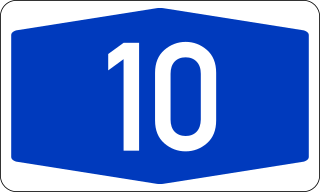
Cologne is the largest city of the German state of North Rhine-Westphalia and the fourth-most populous city of Germany with nearly 1.1 million inhabitants in the city proper and over 3.1 million people in the Cologne Bonn urban region. Cologne is also part of the Rhine-Ruhr metropolitan region, the second biggest metropolitan region by GDP in the European Union. Centered on the left (west) bank of the Rhine, Cologne is located on the River Rhine, about 35 km (22 mi) southeast of the North Rhine-Westphalia state capital Düsseldorf and 25 km (16 mi) northwest of Bonn, the former capital of West Germany.

A ring road is a road or a series of connected roads encircling a town, city or country. The most common purpose of a ring road is to assist in reducing traffic volumes in the urban centre, such as by offering an alternate route around the city for drivers who do not need to stop in the city core. Ring roads can also serve to connect suburbs to each other, allowing efficient travel between them.

Bundesautobahn 555 is an autobahn connecting the cities of Cologne and Bonn. It was constructed between 1929 and 1932, and opened to traffic on 6 August 1932.

Bundesautobahn 4 is an autobahn in two discontinuous segments that crosses Germany in a west–east direction. The western segment has a length of 156 km (97 mi), while the part in the east is 429 km (267 mi) long.

Bundesautobahn 5 is a 445 km (277 mi) long Autobahn in Germany. Its northern end is the Hattenbach triangle intersection. The southern end is at the Swiss border near Basel. It runs through the German states of Hessen and Baden-Württemberg and connects on its southern ending to the Swiss A 2.

Mülheim is a borough (Stadtbezirk) of Cologne in Germany and a formerly independent town. Mülheim is located on the right bank of the Rhine opposite the old town of Cologne.

Bundesautobahn 10 is an orbital motorway around the German capital city of Berlin. Colloquially called Berliner Ring , it is predominantly located in the state of Brandenburg, with a short stretch of 5 km in Berlin itself. It should not be confused with the Berliner Stadtring around Berlin's inner city.

Bundesautobahn 999 was the designated number for the Mittlerer Ring in Munich, Germany, a projected second ring road around the inner city districts to accompany the Münchner Ring (Bundesautobahn 99). The project to construct the Mittlerer Ring as an autobahn was not carried out, instead the Bundesstraße 2R now covers most of the planned A 999 trajectory.

Bundesautobahn 115 is an autobahn in Berlin, Germany. It connects the Berliner Stadtring with the Berliner Ring, using parts of the old AVUS race track. AVUS was opened in 1921 as Germany's first limited access road. After World War II, the A 115 served an important function as a transit road between West Berlin and West Germany. In 1969, a small part of the autobahn was moved eastwards by GDR authorities so that the Checkpoint Bravo border crossing at Dreilinden would be fully on West Berlin territory.
This article covers transportation in and around the city of Cologne, Germany.

Porz is a borough or Stadtbezirk of Cologne, Germany. It is situated on the east side of the Rhine in the south-east of the city. Porz is the largest borough of Cologne by area at 78.92 km2 and has 113,500 inhabitants.
The Cologne Beltway is the collective term for the Autobahns encircling Cologne. It consists of the Bundesautobahn 1, the Bundesautobahn 3 and the Bundesautobahn 4. Segments of the beltway handle the highest traffic volume in Germany.

The Cologne Ring is a semi-circular, some 6 km long urban boulevard in Innenstadt, Cologne and the city's busiest and most prominent street system. The Cologne Ring is a four lane street and part of Bundesstraße 9.

Kalk is the Eighth borough or Stadtbezirk of Cologne, Germany. Kalk was merged into the city of Cologne in 1910, the borough was formed in 1975.

Ehrenfeld is a borough (Stadtbezirk) of the City of Cologne in Germany. It includes the seven quarters Bickendorf, Bocklemünd, Mengenich, Ehrenfeld, Neuehrenfeld, Ossendorf and Vogelsang. It has about 109,500 inhabitants and covers an area of 23.98 square kilometres. The district borders with the Cologne districts of Chorweiler to the North, Nippes and Innenstadt to the East and Lindenthal to the South-West.

Chorweiler is the sixth borough (Stadtbezirk) of Cologne, Germany. Large portion of the borough of Chorweiler were incorporated into the city of Cologne in 1922, the borough of Chorweiler was created in the 1970s. The borough has the lowest population density in Cologne and many areas are very rural.

Nippes is the fifth borough of Cologne, Germany. Nippes was incorporated into the city of Cologne in 1888 and the district was created in 1975. A large Ford Europe production plant is located in Niehl, the north-eastern part of the district.

Innenstadt is the central borough of the City of Cologne in Germany.

Bundesautobahn 559 is an autobahn in Germany.

Heumarkt station is a Stadtbahn interchange station in the historic Altstadt of Cologne, Western Germany. The station is an important hub between (low-floor) East-West and (high-floor) North-South connections.


























